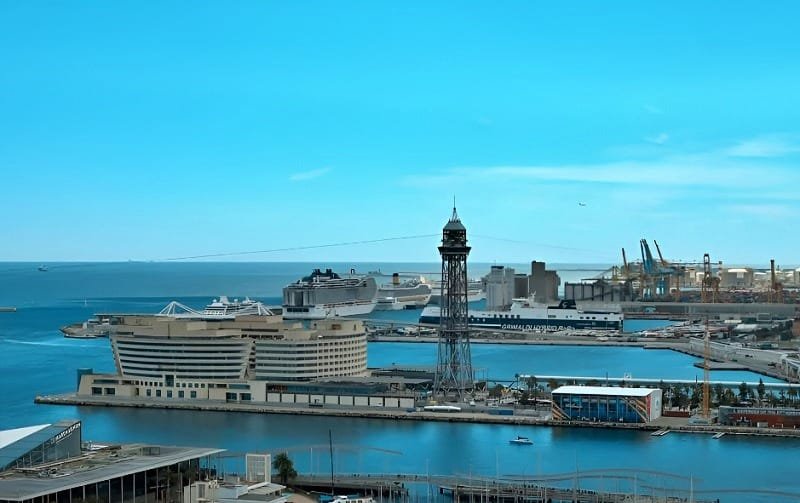The Port of Barcelona has marked a significant milestone in its efforts to lead the transition towards more sustainable maritime transport with a record increase in LNG bunker operations during 2024. The port, a critical hub for liquefied natural gas (LNG) supplies in Europe, has seen a dramatic surge in the use of LNG, confirming its commitment to cleaner maritime fuels and reinforcing its position as one of the region’s top suppliers of this transitional fuel.
Table of Contents
Unprecedented Growth in LNG Bunkering
In 2024, the Port of Barcelona conducted 491 LNG bunkering operations, marking a significant increase from 199 operations in 2023. This surge was driven by a rise in both barge and truck deliveries. The port handled 89 barge deliveries, supplying a total of 184,324 m³ of LNG, while 402 truck deliveries provided 45,427 m³ of LNG. This resulted in an impressive total LNG bunkering volume of 229,751 m³, a notable increase from 143,000 m³ in 2023.
This increase in LNG bunkering volumes is a direct result of the port’s ongoing investment in infrastructure and a robust commitment to offering cleaner alternatives for maritime transport. It signals a clear shift towards sustainable energy solutions that will help decarbonize the maritime industry and reduce the environmental footprint of shipping.
LNG-Powered Vessels Continue to Rise
The demand for LNG as a marine fuel at the Port of Barcelona has also seen a significant increase, with 822 LNG-powered vessels calling at the port in 2024. This represents nearly 10% of the total 8,398 ship calls, more than double the 618 LNG-powered vessels that visited the port in 2023, which accounted for 7% of the total 8,783 ship calls in 2023.
The growth in LNG-powered ship calls at the port is a clear reflection of the maritime industry’s growing commitment to reducing NOx and CO2 emissions. LNG-fueled vessels are now being seen across a wider range of shipping sectors, from cruise ships to container ships and bulk carriers. This transition aligns with broader industry trends and the European Union’s commitment to reducing greenhouse gas emissions from the maritime sector.
Environmental Impact: A Significant Contribution to Emission Reductions
The environmental impact of this transition is substantial. In 2024, LNG-powered vessels that docked at the Port of Barcelona produced 90% fewer NOx emissions compared to those powered by traditional marine fuels like diesel.
The continued adoption of LNG is helping the port make significant strides towards its Energy Transition Plan, which outlines goals to reduce greenhouse gas emissions by 50% by 2030 and to become a carbon-neutral port by 2050.
Expansion of LNG Bunkering Infrastructure
The expansion of LNG bunkering infrastructure at the Port of Barcelona is another key factor behind the 2024 growth. In 2023, the port introduced the Haugesund Knutsen LNG bunkering barge, which has proven to be a game changer for operations, particularly with cruise ships. The barge, which has a 5,000 m³ capacity, was responsible for 127,500 m³ of LNG supplied to 66 cruise ships in 2023.
The flexibility and cost-effectiveness provided by this LNG bunkering barge has been instrumental in driving growth. Its permanent base in Barcelona has enabled the port to offer ship-to-ship bunkering services, reducing service costs and improving operational efficiency. The presence of such infrastructure has also attracted LNG-powered cruise ships such as those from the Carnival Group.
| LNG Bunkering | 2023 | 2024 |
|---|
| LNG Bunker Operations | 199 | 491 |
| LNG Bunker Volumes | 143,000 m³ | 229,751 m³ |
| Total Ship Calls | 8,783 | 8,398 |
| LNG-Powered Ship Calls | 618 | 822 |
LNG Adoption by Various Vessel Types
The Port of Barcelona witnessed a significant shift in the types of vessels adopting LNG. While cruise ships and ferries were the initial early adopters, LNG-powered container ships, bulk carriers, and even vehicle carriers have begun to regularly call at the port. Notably, the CMA CGM Palais Royal, one of the world’s largest container ships, made its first call at Barcelona’s BEST Container Terminal in December 2023.
Baleària, the leading Spanish ferry company, has been a key player in the transition to LNG as a marine fuel, contributing significantly to the growth of LNG bunkering at the Port of Barcelona. As part of its commitment to sustainability and reducing emissions, Baleària has utilized LNG to power several vessels operating in the Mediterranean region.
This diversification of LNG-fueled vessels highlights the broader industry shift towards using low-emission fuels, further cementing Barcelona’s position as a key hub for LNG bunkering in Europe.
Continued Commitment to Clean Fuels
Barcelona’s growing dominance in the LNG bunkering market is backed by its dedication to promoting cleaner maritime fuels. The Port of Barcelona is in the midst of executing its Energy Transition Plan, which emphasizes LNG as a key transitional fuel. The port is exploring new fuel alternatives, including bioLNG, methanol, and ammonia, to help facilitate the broader decarbonization of maritime transport.
The port’s strategic plans also include developing facilities for green methanol production, which will play a pivotal role in the transition to zero-emission fuels for the maritime sector. Additionally, a feasibility study is underway to build a biomethane production plant, using organic waste, to replace LNG as a fuel for ships, marking another important step towards a more sustainable future.

Port of Barcelona’s Role in Europe’s Green Transition
As part of the European Union’s Green Deal and Fit for 55 initiative, the EU has recognized LNG as a vital transitional fuel to decarbonize the maritime industry. With LNG, shipping companies can significantly reduce NOx, SOx, and particulate emissions, offering a cleaner alternative to traditional diesel fuels. This makes LNG crucial for achieving the EU’s decarbonization goals for the maritime sector, particularly in the short to medium term.
As of 2024, the Port of Barcelona remains a beacon of sustainability and a model for other ports to follow, showcasing how LNG bunkering can pave the way for zero-emission maritime fuels in the future.
Looking Ahead to 2025 and Beyond
The future of LNG bunkering at the Port of Barcelona looks incredibly promising. With a growing number of vessels adopting LNG-powered engines, the port is well-positioned to continue its role as a leader in maritime sustainability. The investments in LNG bunkering infrastructure, coupled with strong collaborations with shipping companies, place the Port of Barcelona at the forefront of the global transition towards cleaner maritime fuels.
As the port continues to expand its LNG bunkering services, 2025 promises to be another year of significant growth in both volume and types of vessels utilizing this cleaner fuel option, solidifying the Port of Barcelona’s position as a key player in the energy transition of the maritime sector.
Source Port de Barcelona

